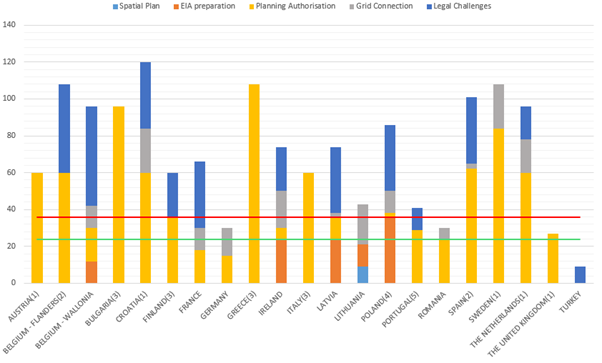[Published: October 2020]
Delivering the Green Deal requires speeding up the installation of wind farms across Europe. As it stands, we expect to build 15 GW a year over 2021-25. That needs to double for Europe to stay on course towards climate neutrality: delivering the 40% renewable energy target for 2030 as part of the “Fit for 55” package will require 30 GW of wind being built each year between 2021 and 2030.
The challenge is not technology, finance or costs. It is permitting. Europe is simply not permitting enough new wind farms to meet its renewable energy targets.
It is too difficult to get permits for new and repowered wind farms in Europe. This is because:
- Rules are complex. There are more and more spatial planning constraints e.g. minimum distance to housing, tip/hub height restrictions, exclusion zones around radar installations or in Natura 2000 sites, etc.
- Procedures are slow. There are too many administrative authorities involved: at national, regional, municipal level. Most EU countries still don’t have a single contact point (i.e. one-stop shop) to expedite the permitting process. And legal challenges add months of delays; and
- Permitting authorities aren’t adequately staffed. Authorities at all levels lack sufficient digital and/or human resources to process a growing number of permitting applications.
All this means that:
- Many projects don’t go ahead; and
- Permitting costs add to development costs and risk which deters investors from developing projects.
And there are wider economic consequences. Wind energy in Europe is 300,000 jobs, 248 factories, €37bn GDP contribution, global technology leadership. Retaining this, let alone increasing it, needs a healthy project pipeline.
The figure below shows the permitting lead time per country for onshore wind farms. Where possible this is broken down per phase of the permit granting process. Article 16 of the Renewable Energy Directive requires Member States to permit new renewable energy projects within 2 years and repowered ones within 1 year (excluding timing for completing Environmental Impact Assessments (EIA) and clearing legal challenges).
WindEurope advises the European Commission by identifying good permitting practices and supporting their dissemination as part of the EU-funded RES simplify project. We aim to empower authorities to accelerate the permitting of wind farms while meeting robust environmental standards in line with the objectives of the EU Green Deal.
Onshore wind permitting lead time

- Planning authorisation likely includes both EIA and planning authorisation
- Planning authorisation includes both EIA and planning authorisation
- Planning authorisation includes EIA, planning authorisation and grid connection permit
- EIA preparation includes obtaining Spatial Plan and Environmental Decision. Planning authorisation only includes obtaining the building permit.
- Planning authorisation includes planning authorisation and grid connection permit
Key links:
- Setting the course towards climate neutrality – WindEurope position on the “Fit for 55” package (position paper/public)
- 8 “to dos” for governments to deliver the expansion of onshore wind needed for the Green Deal (position paper/public)
- RES Simplify project
- National policy and regulatory updates (members only)
- Overview of permitting rules (members only)
- Country by country permitting process briefs (Denmark, France, Germany, Ireland, Spain, Sweden) (members only)

